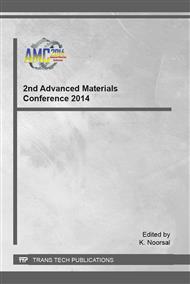p.501
p.505
p.510
p.515
p.523
p.527
p.532
p.537
p.542
Synthesis and Characterization of Fe2O3/TiO2/ SiO2 and Fe2O3/TiO2/Activated Carbon Nanocomposite Photocatalysts for Dye Removal
Abstract:
Magnetic nanocomposite photocatalyst is an alternative approach for easy separation of catalyst from the treated water by magnetic force. This paper will discuss the performance of dye degradation using two different supported layer; Silica and Activated Carbon that shield between magnetic iron oxide (Fe2O3) and Titanium dioxide (TiO2) photocatalyst. Photocatalytic activity is measure using Methylene Blue (MB) as indicator. The magnetic nanocomposite was synthesis using an evaporation indused self-assembly (EISA) approach and wet synthesis method. The photocatalyst were then characterized using Vibrating Sample Magnetometer (VSM), Brunauer-Emmet-Teller (BET), and Transmission Electron Microscope (TEM) and the effect of dye degradation were characterizing using Ultraviolet-Visible (UV-VIS) spectroscopy. The result showed that activated carbon is the good supporter compare to silica.
Info:
Periodical:
Pages:
523-526
Citation:
Online since:
January 2016
Price:
Сopyright:
© 2016 Trans Tech Publications Ltd. All Rights Reserved
Share:
Citation:


